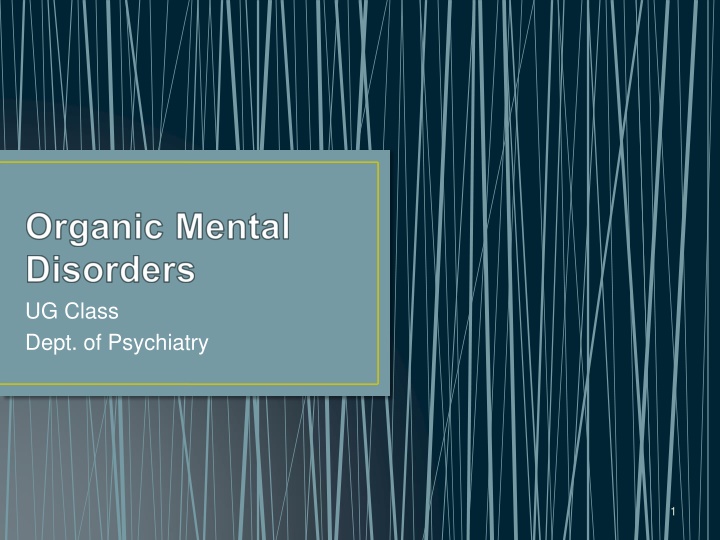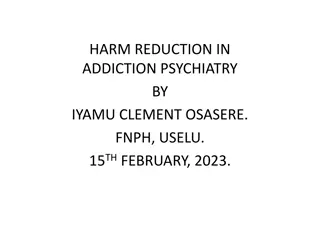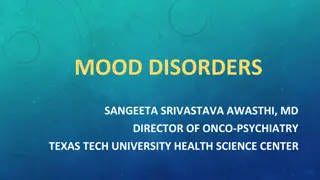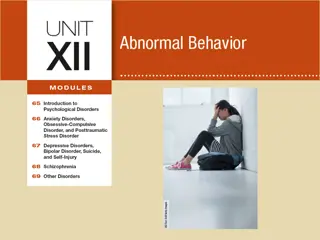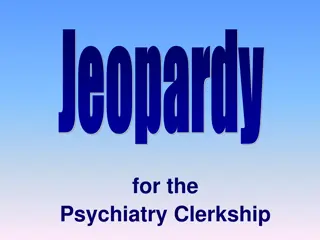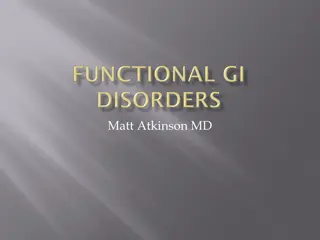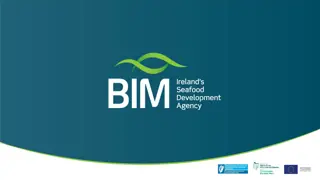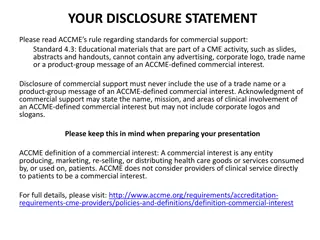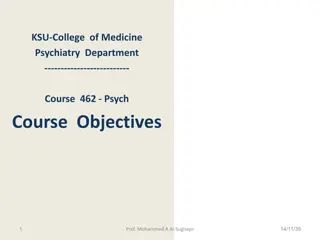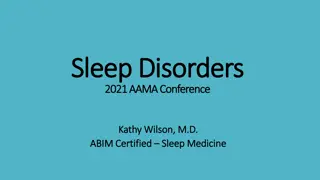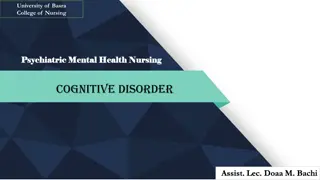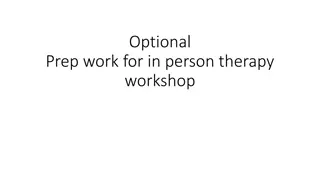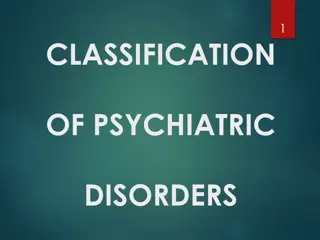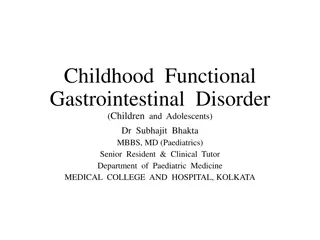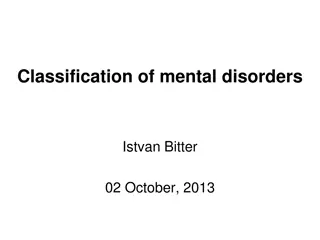Organic vs Functional Disorders in Psychiatry
Traditional distinctions between organic and functional psychiatric disorders are outdated as every disorder has an organic component, emphasizing the interconnectedness of the biological and psychological aspects of mental health. In the context of ICD-10 classification, various conditions like dementia, delirium, and personality disorders due to brain dysfunction fall under the spectrum of organic disorders. A case study of a 78-year-old man admitted for hernia repair highlights the importance of recognizing cognitive decline and behavioral changes in the elderly post-surgery.
Download Presentation

Please find below an Image/Link to download the presentation.
The content on the website is provided AS IS for your information and personal use only. It may not be sold, licensed, or shared on other websites without obtaining consent from the author.If you encounter any issues during the download, it is possible that the publisher has removed the file from their server.
You are allowed to download the files provided on this website for personal or commercial use, subject to the condition that they are used lawfully. All files are the property of their respective owners.
The content on the website is provided AS IS for your information and personal use only. It may not be sold, licensed, or shared on other websites without obtaining consent from the author.
E N D
Presentation Transcript
UG Class Dept. of Psychiatry 1
Traditionally, those disorders which had an identifiable pathological condition such as brain tumour, cerebrovascular disease, or drug intoxication were called as organic. Those brain disorders with no generally accepted organic basis (e.g., depression) were called functional disorders. This distinction between organic vs functional disorders is out-dated now. Every psychiatric disorder has an organic (i.e., biological or chemical) component. 2
In ICD 10, included under F00-F09. It includes- Dementia- Alzheimer s, vascular, others,unspecified. Organic amnestic disorder Delirium Mental disorders due to brain damage/ dysfunction orphysical illness. Personality & behavioral disorders due to brain damage/ dysfunction/ disease. All are characterized primarily by impairment of cognition. 3
A 78 year-old man admitted to the surgery ward for elective hernia repair. The hernia has been enlarging and becoming more painful in the past year, interfering with his appetite. Past hist:- k/c/o Hypertension, BPH, OA of knees that causes difficulty with his ADLs on treatment for the same. Moderate hearing difficulty. History of declining cognitive abilities. In the past few years, and particularly in the past several months, his cognition has declined and he has depended increasingly on his wife for support. Personal hist:- No history of smoking and no alcohol use. O/E:- BP 140/80; Pulse 72 regular; Resp. 16, easy; Temp. 97.0 F. Systemic ex:- CVS, RS, PA- NAD. Lab: normal. Patient was posted for hernia repair and operated for the same. He undergoes hernia repair with no intra-operative problems and with minimal blood loss. 4
Patient is kept in post op ward for observation. In the post op rounds:- Temp 100.8, BP/P/R stable, complains of pain and gets pain killer with relief. Low grade bowel sounds are noted to be present. In the evening, nurses note that the patient is agitated. He is trying to pull out his IV cannula , trying to get out of bed without assistance, is calling out frequently. Noticed to have anger outbursts and claims the staff is trying to harm him. Found to make gestures in the air as if is communicating with someone. Wife reports that this kind of behavior was not observed previously, neither any psychiatric consultation was sorted in the past. O/E- lethargic. It takes several attempts to gain his attention to answer questions. Once focused on a question he rambles in a disorganized way, his speech is incoherent. He is disoriented to time, place & person. Auditory & Visual hallucinations, delusions of persecution are present. There are no focal neurological deficits and his exam is otherwise unchanged. 5
DX--?? History of declining cognitive abilities patient is agitated claims the staff is trying to harm him Found to make gestures in the air as if is communicating with someone. several attempts to gain his attention speech is incoherent He is disoriented to time, place & person Auditory & Visual hallucinations, delusions of persecution are present
Also called as- Acute brain syndrome Acute confusional state Acute infective psychosis Acute organic reaction Acute psycho-organic syndrome ICU psychosis 7
It is defined as acute onset of fluctuating cognitive impairment and a disturbance of consciousness. It is a syndrome, not a disease. Has many causes, all of which result in a similar pattern of signs and symptoms relating to the patient's level of consciousness and cognitive impairment. Hallmark symptom is impairment of consciousness, usually occurring in association with global impairments of cognitive functions. Abnormalities of mood, perception and behaviour are common psychiatric symptoms. Has a sudden onset (hours or days), a brief and fluctuating course, and rapid improvement when the causative factor is identified and eliminated. 8
It is one of the poor prognostic sign. The 3-month mortality rate of patients who have an episode of delirium is estimated to be 23 to 33 percent. The 1-year mortality rate for patients who have an episode of delirium may be as high as 50 percent. Elderly patients who experience delirium while hospitalized have a 20 to 75 mortality rates. Major causes:- CNS disease (like epilepsy), systemic disease (like infections, cardiac failure), and intoxication or withdrawal from pharmacological or toxic agents (like alcohol). 9
1. Central nervous system disorder:- Seizures, Migraine, Head trauma, brain tumor, subarachnoid hemorrhage, subdural, epidural hematoma, abscess, ICH, cerebellar hemorrhage, nonhemorrhagic stroke, transient ischemia 2. Metabolic disorder:- Electrolyte abnormalities, DM, hypoglycemia, hyperglycemia, or insulin resistance 3. Systemic illness Infection:- Sepsis, malaria, viral, plague, Lyme disease, syphilis, or abscess, Trauma, Change in fluid status , Nutritional deficiency, Burns, Uncontrolled pain,Heat stroke, High altitude (usually >5,000 m) 4. Medications :- Antibiotics, antivirals, and antifungals, Steroids, Anesthesia, Cardiac medications, Antihypertensives, Antineoplastic agents, Anticholinergic agents,NMS, Serotonin syndrome , OTC preparations Herbals, teas, and nutritional supplements. 5. CVS:- Cardiac failure, arrhythmia, myocardial infarction, cardiac assist device, cardiac surgery 9
6. RS:- COPD, hypoxia, SIADH, acid base disturbance 7. Endocrine:- Adrenal crisis or adrenal failure, thyroid abnormality, parathyroid abnormality 8.Hematological:- Anemia, leukemia, blood dyscrasia, stem cell transplant 9.Renal:- Renal failure, uremia, SIADH 10.Hepatic:- Hepatitis, cirrhosis, hepatic failure 11.Neoplasm:- Neoplasm (primary brain, metastases, paraneoplastic syndrome)
1. 2. Clouding of consciousness. Disturbance of cognition: a. impairment of immediate & memory, with relatively intact remote memory; b. disorientation to TPP. Psychomotor disturbances: a. shifts from hypo-activity to activity; b. increased reaction time; c. increased or decreased flow of speech; d. enhanced startle reaction. Disturbance sleep-wake cycle: a. sleep-wake cycle; b. nocturnal worsening of symptoms (sun downing); c. disturbing dreams and nightmares which may continue as hallucinations or illusions after awakening. Rapid onset and fluctuations of the symptoms over the course of the day. Objective evidence from history, physical and neurological examination or laboratory tests of an underlying cause. recent 3. hyper- 4. insomnia or reversal of the 5. 6. 10
Major neurotransmitter hypothesized in delirium is acetylcholine. Major neuroanatomical area is the reticular formation. Usually diagnosed at the bedside and is characterized by the sudden onset of symptoms. Bedside mental status examination can be used to document the cognitive impairment and to provide a baseline from which to measure the patient's clinical course. Physical examination often reveals clues to the cause. The presence of a known physical illness or a history of head trauma or alcohol or other substance dependence increases the likelihood of the diagnosis. 11
The symptoms usually persist as long as the causally relevant factors are present, although delirium generally lasts less than a week. After identification and removal of the causative factors, the symptoms usually recede over a 3- to 7-day period. The older the patient and the longer the patient has been delirious, the longer the delirium takes to resolve. Management- Identification of the underlying cause & correction of the cause. Supportive treatment for the same. 14
Important goal of treatment is to provide physical, sensory, and environmental support. Physical support:- to prevent pts getting into accidents. Patients should be neither sensory deprived nor overly stimulated by the environment. Familiar pictures and decorations. Presence of a clock or a calendar. Regular orientations to person, place, and time help make patients with delirium comfortable. Delirium can sometimes occur in older patients wearing eye patches after cataract surgery (black-patch delirium). Such patients can be helped by placing pinholes in the patches to let in some stimuli or by occasionally removing one patch at a time during recovery. 15
The two major symptoms that require pharmacological treatment- Psychosis and Insomnia. Psychosis is best treated with antipsychotics like- haloperidol (Serenace), SGAs like risperidone, quetiapine, olanzapine & aripiprazole. Insomnia is best treated with benzodiazepines with short or intermediate half-lives like-lorazepam. In case of alcohol withdrawal longer acting drugs are used. In intractable delirium, ECT can also be considered. 16
A 66-year old male high school science department head, an experienced and enthusiastic camper and hiker, becameextremely fearful while on a trek in the mountains. Gradually, over the next few months, he loses interest in hisusual hobbies. Formerly a voracious reader, he stopsreading. Develops difficulty doing computations and makes gross errorsin home financial management. On several occasions, he becomes lost while driving in areasthat were formerly familiar to him. He begins to write notes to himself so that he would not forget todo errands. Very abruptly he decided to retire fromwork. Intellectual deterioration gradually progresses. He spends mostof the day piling miscellaneous objects in one place and then transporting them to another spot in thehouse. He becomes stubborn and querulous. Eventually, he requires assistance in shaving and dressing. 17
When examined 6 years after the first symptoms had developed,the patient is alert and cooperative. He is disoriented with respect to place and time. He could notrecall the names of four or five objects after a 5-minute interval of distraction. He could not remember the names of his college and graduate school or the subject in which he had majored. He could describe his job by title only. His speech is fluent and well articulated, but he has considerable difficulty finding words and uses many long, essentially meaningless phrases. He does simple calculations poorly. He could not copy a cubeor draw a house. His interpretation of proverbs isconcrete. He has no insight into the nature of his disturbance. Neurological examination reveals nothing abnormal, and routine laboratory tests are also negative. A CT showed marked cortical atrophy. 18
DX-?? extremely fearful while on a trek. loses interest in his usual hobbies makes gross errors in home financial management. becomes lost while driving in areas that were formerly familiar write notes to himself so that he would not forget Intellectual deterioration gradually progresses he requires assistance in shaving and dressing. patient is alert and cooperative difficulty finding words could not recall the names of four or five objects, names of his college proverbs is concrete could not copy a cube or draw a house no insight into the nature of his disturbance
Defined as progressive impairment of cognitive functions occurring in clear consciousness (i.e., in the absence of delirium). It consists of a variety of symptoms that suggest chronic and widespread dysfunction. Global impairment of intellect is the essential feature, manifested as difficulty with memory, attention, thinking, and comprehension. Other mental functions can often be affected, including mood, personality, judgment, and social behaviour. 20
Types of Dementia Alzheimer s Disease (AD) Vascular Dementia Fronto Temporal Dementia (FTD) Pick s Disease Dementia with Lewy Bodies (DLB) Creutzfeldt-Jakob Disease (CJD) Huntington s disease (HD) Parkinson s disease (PD) Wernicke-Korsakoff Syndrome And more.. More then half of all dementias are Alzheimer s Disease, followed by Vascular Dementia. AD and other forms of dementia are irreversible, however there are some that can be reversed with the appropriate treatment. 18
AD is the 4th most common cause of death after heart disease, cancer and stroke. Gradual onset and continuous cognitive decline. Late-onset AD occurs at 65 years of age and up (majority). Early-onset AD can occur between age 40 and 65 years. There is no cure for AD, however there are several treatments to help slow down progress ofAD Interventions Anti-depressants /Antipsychotics Nutrition, meaningful activities, and a familiar environment. 22
Usually the first symptom to emerge in AD and many other dementias is forgetfulness. Increasing impairment of learning and short term memory. Impoverished speech. Shrinking vocabulary and decreased word fluency. Patient is aware of these difficulties and may avoid new situations to minimize embarrassment or failure. May become depressed as they realize what s happening (presence of insight). Difficulty with perception (agnosia) or executive movements (apraxia). 23
Difficulties with executive functions. Abstract thinking gradually becomes difficult. Difficulty comprehending novel situations and subtle changes of language and nonverbal expression. Frequent incorrect word substitutions (paraphasia). Delusions and hallucinations. Personality changes. Rapid changes in emotion / agitation. Impaired long-term memory. 24
Profound anterograde and retrograde amnesia. Poor judgement and impulse control Disinhibited behaviours are common. Loss of insight (Anosognosia) Alleviates depression. Extreme apathy and exhaustion. Loss of spontaneous speech / Mute. Vegetative state Complete dependence on caregivers. 25
1. Evidence of each of thefollowing: a.Decline in memory b.Decline in other cognitive abilities - deterioration in judgement and thinking (planning and organizing) and in the general processing of information. 2. Preserved awareness of theenvironment a.During a period of time long enough to enable the unequivocal demonstration of 1. 3. A decline in emotional control or motivation, or a change insocial behaviour, manifest as at least one of thefollowing: a.Emotional lability; b.Irritability; c.Apathy; d.Coarsening of social behaviour. 4. For a confident clinical diagnosis, 1 should have been present for at least six months; if the period since the manifest onset is shorter,the diagnosis can only be tentative. 26
Alzheimer's- early onset- rapid onset & progression. Aphasia, alexia, acalculia, apraxia. Alzheimer s- late onset- very slow, gradual onset & progression. Predominance of memory impairment over intellectual impairment. Vascular dementia- Unequal distribution of deficits in higher cognitive functions with some others relatively spared. Thus memory may be quite markedly affected while thinking, reasoning and information processing may show only mild decline. areas affected and 27
Picks disease- predominance of frontal lobe features & behavioural manifestations. CJD- progresses rapidly over months to 1 or 2 years and is accompanied or followed by multiple neurological symptoms. Huntington s disease- Involuntary choreiform movements (typically of the face, hands, and shoulders, or in the gait) are early manifestations. They usually precede the dementia. 28
Some patients with depression have symptoms of cognitive impairment which is difficult to distinguish from symptoms of dementia. This clinical picture is sometimes referred to as pseudo- dementia or depression-related cognitive dysfunction. Clinical features distinguishing from true dementia- pt complain of cognitive loss, emphasize disability, highlight failures, make little effort even to perform simple tasks, pervasive affective change. 29
First step- Verification of the diagnosis. Accurate diagnosis is imperative, for the progression may be halted or even reversed if appropriate therapy is provided. Preventive measures are important, particularly in vascular dementia. They might include changes in diet, exercise, and control of diabetes and hypertension. Pharmacological agents might include antihypertensive, anticoagulant, or antiplatelet agents. Blood pressure control should aim for the higher end of the normal range. Surgical removal of carotid plaques may prevent subsequent vascular events in carefully selected 27
General treatment approach- to provide supportivemedical care, emotional support for the patients and their families, and pharmacological treatment for specific symptoms, including disruptive behaviour. Patients often benefit from a supportive andeducational psychotherapy in which the nature and course of their illness are clearly explained. Also benefit from assistance in grieving and acceptingthe extent of their disability and from attention to self-esteem issues. 28
Areas of intact functioning should be maximized by helping patients identify activities in which successful functioning is possible. BZDs for insomnia and anxiety, antidepressants for depression, and antipsychotic drugs for delusions and hallucination.
